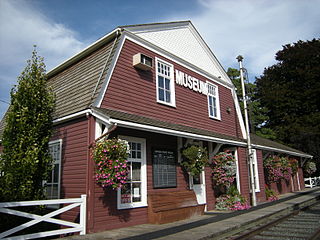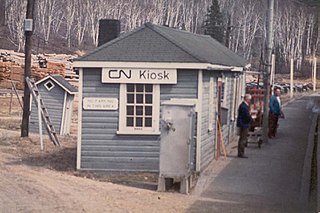
Union Station is a major railway station and intermodal transportation hub in Toronto, Ontario, Canada. The station is located in downtown Toronto, on Front Street West, on the south side of the block bounded by Bay Street and York Street. The municipal government of Toronto owns the station building while the provincial transit agency Metrolinx owns the train shed and trackage. It is operated by the Toronto Terminals Railway, a joint venture of the Canadian National Railway and Canadian Pacific Railway, which directs and controls train movement along the Union Station Rail Corridor, the largest and busiest rail corridor in Canada. Constructed in 1927, Union Station has been a National Historic Site of Canada since 1975, and a Heritage Railway Station since 1989.

The Canadian is a transcontinental passenger train operated by Via Rail with service between Union Station in Toronto, Ontario, and Pacific Central Station in Vancouver, British Columbia, Canada.

The Super Continental was a transcontinental Canadian passenger train operated by the Canadian National Railway from 1955 until 1977, when Via Rail took over the train and ran it until it was cancelled in 1981. Service was restored in 1985 but was again eliminated in 1990. The original CN train had a Montreal–Ottawa–Toronto-Winnipeg–Saskatoon–Edmonton–Jasper–Vancouver routing with daily service.

The Atlantic was a passenger train operated by Via Rail, serving both Canadian and U.S. territory between Montreal, Quebec, and Halifax, Nova Scotia. It was previously operated by Canadian Pacific Railway as The Atlantic Limited between Montreal and Saint John, New Brunswick. It formed part of the transcontinental service for both systems.

Kitchener station is a railway station located in Kitchener, Ontario, Canada, slightly to the northeast of downtown Kitchener, at 126 Weber Street West, near the corner of Victoria Street. It is a heritage building containing a waiting room and ticket counter built beside a set of tracks also used as a freight yard. A separate building to the east of the passenger area, originally built in 1925 as a freight building, now serves as the headquarters for the Goderich–Exeter Railway.
The Dugald rail accident was a head-on collision between two Canadian National passenger trains on September 1, 1947, in Dugald, Manitoba, Canada, resulting in the deaths of 31 people.

The International was a named passenger train operated between Chicago and Toronto. It was originally an overnight train operated by the Grand Trunk Railway of Canada and its successors the Canadian National Railway and Grand Trunk Western Railroad, running as far as Montreal. The train was cut back to Port Huron, Michigan, in 1970 and discontinued in 1971.
The Canada Atlantic Railway (CAR) was a North American railway located in Ontario, southwestern Quebec and northern Vermont. It connected Georgian Bay on Lake Huron with the northern end of Lake Champlain via Ottawa. It was formed in 1879 through a merger of two separate railway companies that John Rudolphus Booth had purchased, and reached its full extent in 1899 through a third company that he had created. The CAR was owned by Booth for several years after its completion until he agreed to sell it to the Grand Trunk Railway (GTR) in 1904.
The Kawartha Lakes Railway was a Canadian rail line. It was created in 1996 to assume the operations of the Havelock and Nephton Subdivisions of the Canadian Pacific Railway which serve the Peterborough, Ontario area.
Boston Bar station is a railway station in Boston Bar, British Columbia, Canada, located at the border of CN's Ashcroft subdivision.
North Bend station is a railway station in North Bend, British Columbia, Canada, located at the border between CPR's Cascade and Thompson subdivision.

Hope station is a Via Rail flag stop at Hope in southwestern British Columbia, Canada. Formerly, a Canadian National Railway (CN) station stood at this location and a Kettle Valley Railway (KV) one to the northwest.
Chilliwack station is a railway station in Chilliwack, British Columbia, Canada. The station consists solely of a signpost and paved low-level platform located on the north side of the CN Railway tracks at Nowell Street.
Abbotsford station is a railway station in Abbotsford, British Columbia, Canada, located along CN railway tracks.
Mission Harbour station is a railway station in Mission, British Columbia, Canada, located along CPR's Cascade subdivision. It sits just north of the Mission Railway Bridge at Harbour Avenue.

Agassiz station is a railway station in Agassiz, British Columbia, Canada, located along CPR's Cascade subdivision. The station is served by Via Rail's The Canadian as a flag stop.
Katz station is a railway station in Katz, British Columbia, Canada. It serves as a flag stop for Via Rail's The Canadian train. It is on the Canadian Pacific Railway Cascade subdivision, east of Ruby Creek.
The Georgian Bay and Seaboard Railway (GB&S) was a former short-line railway in Ontario, Canada, owned and operated by Canadian Pacific Railway (CPR). The first sections opened in 1908, and the entire 140 kilometres (87 mi) route was fully completed in 1912.

The Canadian National Railway (CN) Bala Subdivision is a major railway line in Ontario, Canada. It runs between the provincial capital of Toronto in Southern Ontario and Capreol in Northern Ontario, where the line continues as the Ruel Subdivision. It forms part of CN's transcontinental mainline between Southern Ontario and Western Canada.

The Canadian National Railway Alderdale Subdivision was a railway line in Northeastern Ontario, Canada. It originally opened in 1915 as a part of the Canadian Northern Railway's transcontinental mainline. It connected Brent in the east with Capreol in the west. At Capreol it formed the eastern component of an east-west-south wye junction. The line's divisional point was at Alderdale.












